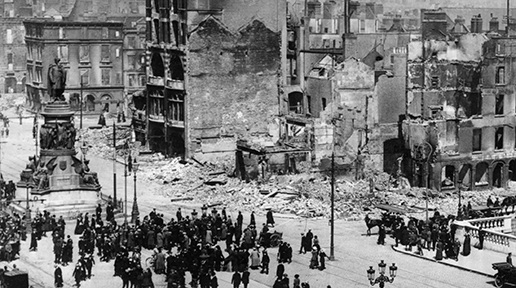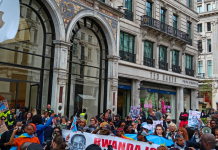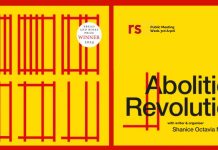For the centenary of the Easter Rising of 1916 we republish Shaun Harkin‘s account of the life of Irish Marxist and revolutionary James Connolly.

James Connolly was executed by a British firing squad on May 12, 1916, in Dublin City along with other leaders of what became known as the Irish Easter Rising. At his court martial trial, Connolly described the aim of the action: “We went out to break the connection between this country and the British Empire, and to establish an Irish Republic.” Today, Ireland’s political establishment canonizes Connolly as a great “Irish patriot.” And yes, Connolly certainly did believe in Ireland’s right to self-determination. However, the Republic of Ireland’s elites would feel ill at ease in Connolly’s company. As he prophetically warned:
“If you remove the English army tomorrow and hoist the green flag over Dublin Castle, unless you set about the organization of the Socialist Republic, your efforts will be in vain. England would still rule you. She would rule you through her capitalists, through her landlords, through her financiers.”
Connolly, unlike the other leaders of the 1916 Irish Rebellion, was a revolutionary Marxist. He had been active as a socialist organizer, militant trade unionist and writer for almost 30 years in Scotland, Ireland and America. It was to Marxism and working-class emancipation that Connolly dedicated his life.
Connolly was born to impoverished Irish immigrants in a ghetto of Edinburgh, Scotland. His father worked as manure carter in the city’s slums. Connolly himself started working when 10 or 11 years old. Then, as for young people now, poverty drove him to enlist in the British Army at age 14. He served seven years, including in Ireland, before deserting in 1889. Lacking formal education, Connolly nevertheless equipped himself with a wide knowledge of history and Marxist theory to become a socialist propagandist and working-class intellectual of the first order.
Victimized for his political activity in Scotland, Connolly moved to Ireland, where he began organizing the Dublin Socialist Club in 1896, quickly transforming it into the Irish Socialist Republican Party (ISRP). The ISRP produced the first regular socialist paper in Ireland, the Workers’ Republic, ran candidates in local elections and represented Ireland in the Second International alliance of socialist organizations.
The party rose to prominence through a spectacular campaign to ruin Queen Victoria’s Diamond Jubilee visit in 1897. Activists made a large black coffin, inscribed with the words “British Empire.” On Connolly’s suggestion, marchers threw the coffin in Dublin’s River Liffey and shouted, “Here goes the British Empire. To hell with the British Empire!” Connolly was arrested, and the protesters were baton-charged off the streets by police, but the world had learned that Dublin was “disloyal.”
At the same time, according to biographer C. Desmond Greaves, “[E]ducational work was intensified, and indoor lectures on the Communist Manifesto and ‘revolutionary socialism’ proceeded to their logical culmination on March 12, when Connolly lectured on the Paris Commune.”
Connolly’s unique contribution to Marxism comes from his assertion that the struggle for national liberation and socialism were inseparable.
Socialists in the colonies, he argued, should lead the struggle for national liberation. Such a revolt in the colonies, he argued, could speed up the process of revolution in economically advanced countries because denying access to markets “precipitates economic crises there, and so gives an impulse to revolutionary thought.” Connolly broke from the conventional elitist notion that socialists in impoverished colonies had to “hold off” the struggle for workers’ power until capitalism was fully developed there.
At the same time, he challenged the idea that revolution should be left to secret nationalist conspiratorial groups: “The socialists broke from this ridiculous secrecy, and in hundreds of speeches in the most public places of the metropolis, as well as in scores of thousands of pieces of literature scattered around the country, announced their purpose to muster all the forces of labour for the revolutionary reconstruction of society and the incidental destruction of the British Empire.”
Connolly worked with advanced Irish Nationalists, but also challenged their strategy of appealing for the “unity” of the Irish people, arguing instead that only working-class struggle could fully end British rule. The Irish rich, Connolly argued, “have a thousand economic strings in the shape of investments binding them to English capitalism, as against every historical attachment drawing them towards Irish patriotism; only the Irish working class remain as the incorruptible inheritors of the fight for Irish freedom.”
Connolly adamantly opposed Loyalist ideas among Protestant workers, but fought to create a space where Catholic and Protestant workers could unite on the basis of class politics. He was sharply aware of why Protestant workers accepted sectarian ideas, but argued: “When the Sinn Feiner speaks to men who are fighting low wages and tells them that the Sinn Fein body has promised lots of Irish labour at low wages to any foreign capitalist who wishes to establish in Ireland, what wonder if they come to believe that a change from Toryism to Sinn Feinism would simply be a change from the devil they know to the devil they do not know.” On the question of the partition of Ireland into two separate states, Connolly, though he did not live to see it, was again remarkably perceptive. He argued it would “mean a carnival of reaction both North and South, would set back the wheels of progress, and destroy the oncoming unity of the Irish labour movement, and would paralyse all advanced movements, whilst it endured.”
In fact, after partition took place in 1921, the ruling elites used Orangeism in the North and nationalism in the South to cement conservative pro-business politics and institutionalise sectarian divisions between Protestant and Catholic workers. Today, Rev. Ian Paisley, the Loyalist bigot who is set to become Northern Ireland’s “first minister” embodies the “carnival of reaction” Connolly warned about.
Connolly went to the USA in 1903 and spent seven years there. Initially attracted to the Socialist Labour Party because of its commitment to revolution over reformism, he reoriented toward the militant unionism of the Industrial Workers of the World.
Connolly returned to Ireland a committed revolutionary syndicalist. He believed in building “One Big Union” and that “[e]very fresh shop or factory organised under the control of industrial unions is a fort wrenched from the control of the capitalist class, and manned with the soldiers of the Revolution to be held by them for the workers.”
Connolly put his ideas into practice as an organiser for the Irish Transport and General Workers Union (ITGWU). Along with James Larkin, he led one of Ireland’s hardest-fought labour struggles, known as the Great Dublin Lockout of 1913-14. Unfortunately, despite a heroic effort, the ITGWU went down to a brutal defeat. This tragedy was followed by another in 1914 when the international socialist movement collapsed into support for the warring imperial powers in the First World War. “The signal for war ought to have been the signal of rebellion,” Connolly wrote. “[W]hen the bugle sounded the first note of actual war, their notes should have been taken as the tocsin for social revolution.”
Faced with the defeat of the Irish labour movement and the collapse of socialist parties internationally, Connolly could have easily succumbed to demoralisation.

Instead, he held on to an internationalist spirit, and attempted to act by striking a blow against the British Empire. This desperate context is how Connolly’s role in the 1916 Rising should be understood. He hoped revolt in Ireland could act as a catalyst to encourage the reemergence of European socialist opposition to the war:
Even an unsuccessful attempt at social revolution by force of arms following the paralysis of the economic life of militarism would be less disastrous to the socialist cause than the act of socialists in allowing themselves to be used in the slaughter of their brothers.
The Easter Rising was isolated and defeated. Though the rebels succeeded in taking over key locations in Dublin and declaring an Irish Republic, the rebellion was suppressed after six days of fighting. Its leaders, including Connolly, were captured, put on trial and executed.
But Connolly was correct in thinking that the crisis of the war could be channelled into revolt. In 1917, 10,000 workers rallied in Dublin to show their support for the Russian Revolution, and that year marked the beginning of a radical upsurge in Ireland that lasted until 1923.
James Connolly was an exceptional working-class fighter and anti-imperialist and his ideas and actions continue to be a source of inspiration today.
Originally published in 2007 in the US Socialist Worker. A James Connolly Reader, Shaun Harkin’s collection of James Connolly’s most important speeches and writing is available via Haymarket Books.



















Connolly’s support for a German victory wasn’t about supporting the aims of German imperialism, it was a firmly held position of revolutionary defeatism. Just as Lenin called for the defeat of the Russian Army as a defeat for Tsarism, so Connolly saw a German victory as a defeat for the British Empire.
There is also a long history of anti imperialist struggles using the logic of competing imperial blocs to gain material support for their cause. This is particularly prevalent in the history of the Irish struggle. Indeed, the Bolsheviks themselves used guns from the US to outfit the Red Army in the Civil War.
I think given this logic, what is more noteworthy is that Connolly’s HQ was adorned with the banner ‘Neither King or Kaiser but Ireland.’ This was in part as a rebuke to right wing elements within the national movement for whom the distinction between material alliance and political support wasn’t so nuanced.
“Just as Lenin called for the defeat of the Russian Army as a defeat for Tsarism, so Connolly saw a German victory as a defeat for the British Empire.”
But Lenin abandoned that call rather quickly after the Bolsheviks roundly rejected it: https://www.marxists.org/archive/draper/1953/defeat/chap3.htm#s12
I admire Connolly but why gloss over his support for German imperialism during WWI on a lesser-evil basis? People who are interested in this topic should read the following
https://theirishrevolution.wordpress.com/2015/12/03/james-connolly-germany-and-the-first-world-war-was-connolly-a-proto-lenin/
https://www.marxists.org/archive/connolly/ (August 1914 onward)
https://www.marxists.org/archive/connolly/1914/08/germmili.htm
Connolly’s pro-German victory position on WWI was by no means exceptional among Irish nationalists who had a long-standing relations with the German government in the form of arms smuggling:
http://www.americanrifleman.org/articles/2016/3/17/guns-of-the-easter-rising/
Do the above facts disqualify Connolly for the ‘anti-imperialist’ label given to him by the author? Why or why not?
Video of Shaun giving a talk on the subject at a centenary rs21 meeting in Manchester:
https://youtu.be/DmJ4A8mHvXI